Botrytis cinerea is one of the most common plant-damaging fungi. We introduce the annoying fungus and show how to fight it successfully.
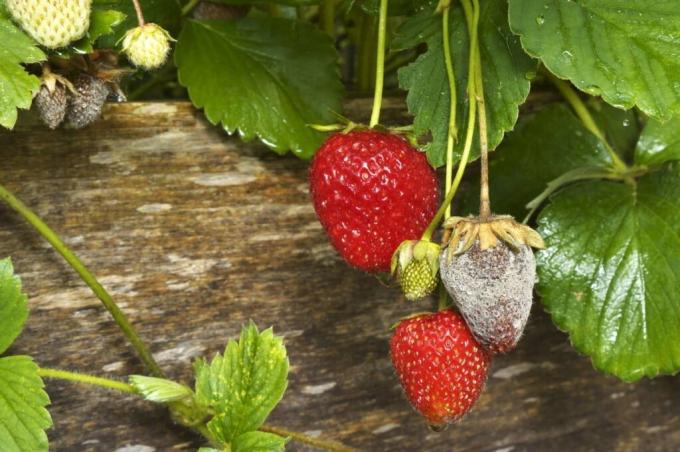
Who doesn't know it, the gray moldy lawn on loved ones strawberries? This is mostly from Botrytis cinerea caused, the gray mold. With a little knowledge about the fungus, you can prevent or control the infestation. We will show you how to do this so that you can enjoy your plants for a long time.
contents
- Botrytis cinerea: The life cycle
- Botrytis cinerea: recognize damage
-
Successfully combat botrytis and drive away gray mold
- Combat Botrytis cinerea: Suitable pesticides
- Combat Botrytis cinerea: Natural measures
- Clever prevention of botrytis
The mushroom Botrytis cinerea is a wound and weakness parasite and is extremely adaptable, so it has a strong tendency to develop resistance. It is one of the most difficult pathogens to control and can cause us concern on various plants in our garden.
Botrytis cinerea: The Life Cycle
This fungus belongs to the class of sac fungi (Ascomycetes) and has a large host plant range. This class owes its name to the shape of its reproductive organs. The sac fungi include 45,000 different species and are therefore the largest and most important group among the real mushrooms. To the Ascomycetes include apple scab (Venturia inaequalis), ergot (Secale cornutum) or the brush mold (penicillium), which is known from the production of antibiotics.
The conidia (asexual fungal spores) form on the decaying areas. Gray mold conidia are spread by wind or spray, infecting new plant tissue. Infection occurs when there is prolonged moisture. The infection then spreads through the fruit and plant. The well-known gray mold lawn can then be observed on strawberries. However, the fruit can also be infected directly.
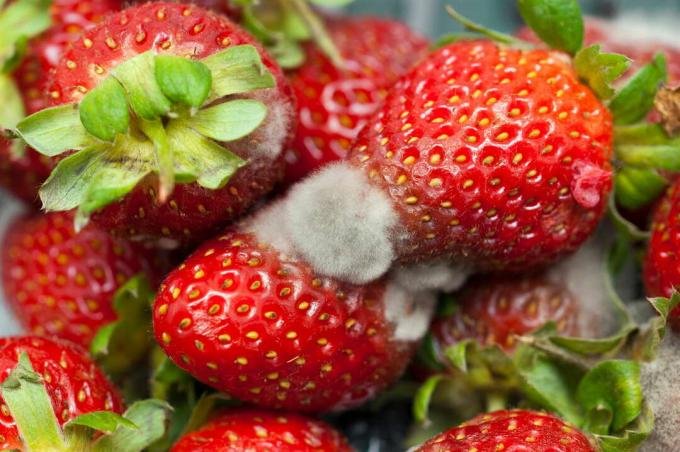
The fungus hibernates on organic material and in spring its development begins again. Sclerotia are formed as a permanent form, but the fungus can also overwinter as mycelium on dead plant parts. Sclerotia are hard permanent forms of fungi that are very resistant to drought or cold, this allows fungi to remain in a dormant state for a long time before conditions are optimal for them again gives. The development is started by the humid conditions in spring and with that the growth of the fungus starts again and with it the formation of new spores.
The development cycle of gray mold at a glance:
- There are sclerotia in the soil that can survive there for a long time.
- The fungus can also survive as mycelium on organic material.
- From these sources, the spores spread and infect our plants.
- It is spread by wind or splashing water.
- A gray layer of fungus develops on the plants, on which spores also form.
- Humidity and temperatures between 20 and 28 °C are optimal for the gray mold.
Botrytis cinerea: detect damage
As its name suggests, a flat, mouse-grey fungal lawn forms when infested with gray mold. This mushroom lawn has the habit of dusting heavily. The tissues of the plants die off, and brown spots also form on the leaves and fruits. The fruits look rather glassy at the beginning. So-called ghost spots can appear on tomatoes. A bright center forms and around this center, with some distance, a bright ring.
The fungus can occur on all parts of the plant, soft fruits and flowers are particularly susceptible to attack, but shoots and woody parts can also come into contact with gray mold.
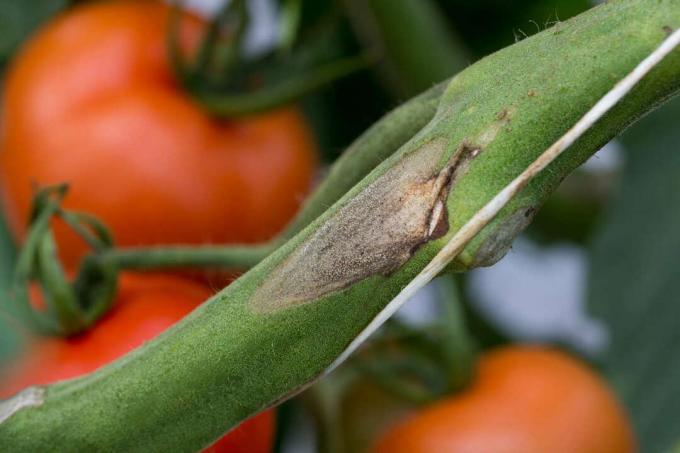
Particularly susceptible crops are tomatoes, cucumbers, onions and salad. In the case of berries, the gray mold is particularly prevalent on strawberries, raspberries, gooseberries and blackberries apart and does not stop at our ornamental plants. roses, tulips, rhododendron and hydrangeas are just some of the affected ornamental plants in our gardens.

botrytis successfully combat and drive away gray mold
There are several approaches to controlling gray mold. Here we show you tips and tricks for prevention and various countermeasures.
Botrytis cinerea combat: Suitable spray agents
The chemical control of Botrytis cinerea is somewhat problematic. This fungus is extremely adaptable and can develop resistance very quickly. Therefore, you should first apply our preventive and natural control measures before resorting to chemical control. Studies on raspberries from northern Germany show that 100% resistance can develop after just five years.
If you see no way out, the following active ingredients can promise success:
- trifloxystrobin
- cyprodinil
- fludioxonil
- soil fungus Gliocladium catenulatum
Caution should always be exercised when using pesticides. Always follow the directions for use, especially personal safety and dosing information.
Botrytis cinerea combat: natural measures
Some methods against gray mold have also proven themselves in a natural way. On the one hand, the use of various liquid manure and teas to combat and prevent it should be mentioned, since many of these remedies are plant strengtheners. Healthy and strong plants will not be attacked by disease as quickly as plants in a weakened state.
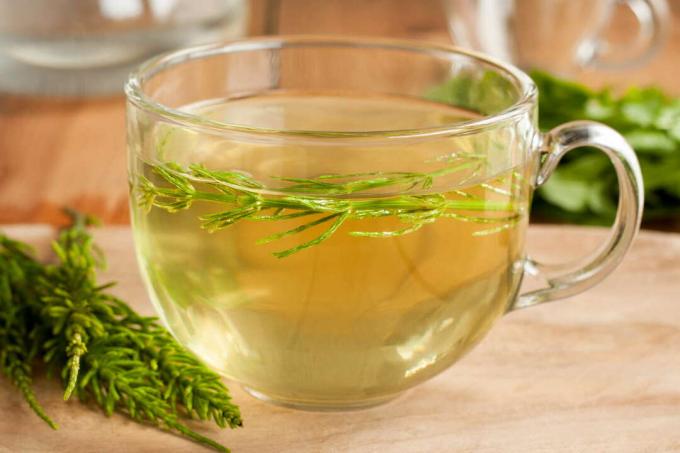
For example, horsetail broth can be sprayed on for strength. With strawberries, dip the roots in horsetail broth before planting to encourage growth later with diluted nettle manure and defoliates the plants a little if the stock is very dense is. Here you can find out more about the horsetail broth and the nettle manure.

However, it is important to look for a new location for the strawberries after three years at the latest. Since the strawberry flowers are affected, you can dust them with rock flour to reduce the infestation. The rock flour can also be applied to the soil as a fertilizer - especially on acidic soils as a soil improver. But don't overdo it with fertilization. A lot of nitrogen can be beneficial for fungal infections, so use it sparingly.

botrytis prevent cleverly
Since the fungus survives the winter on organic material, we already have the first point of attack. Remove dead plant parts, these are full of spores and will only infect more plants. It is important to have as few sources of infection in the garden as possible.
Dealing with moisture, which promotes moisture, is also particularly important botrytis. Therefore, the planting distance between your plants should not be too narrow. A larger distance promotes good air circulation and promotes faster drying. Varieties that develop smaller leaves also help, as they dry off faster.
You should also pay special attention to your casting practice. Do not water from above, this will wet the whole plant and create optimal conditions for fungal infection. Therefore, it is best to water the plants where they really need the moisture - namely on the ground. If you work with irrigation systems, rely on drip irrigation.
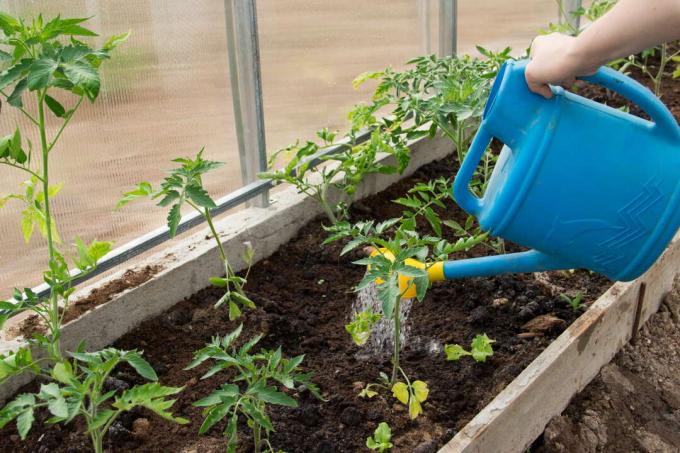
With strawberries, you should be careful when using straw. Of course it is practical if the strawberries are not full of soil, but you should not spread the straw around the strawberry plants from the beginning. It is sufficient if you spread it on the ground shortly before or during flowering. Unfortunately there is no against botrytis resistant strawberry varieties.

Make sure you rotate crops in your garden and change the location of your ornamental plants regularly. A mixed culture can be used in the vegetable patch garlic or onions achieve a preventive effect. The mustard oils in these plants act against the fungus. You can also leave the garlic and onion residues in the garden and incorporate them into the soil. The mustard oils are effective against various pathogens and pests.

If you own a glass house, you should make sure that the humidity is not too high and that dew does not form on the leaves. Regular ventilation or the use of automatic window regulators is particularly important.
A special storage tip: Cool the harvested fruit, especially berries, quickly to 0 to 3 °C. This keeps them fresh longer, otherwise potentially infected fruits could cover your entire harvest with the gray mold lawn. Also try not to touch the fruit as much as possible and not to damage it.

botrytis prevent: once again briefly summarized
- Remove infected and dead plant parts
- Greater plant spacing
- Do not pour from above but close to the ground
- Lay the straw on the ground only after the strawberry blossom
- Crop rotation and relocation
- Mixed culture with garlic
tip: To strengthen the plants most commonly susceptible to botrytis and make them more resistant, we recommend our Plantura organic tomato fertilizer. This is ideal for vegetables and berries and has a high potassium content.
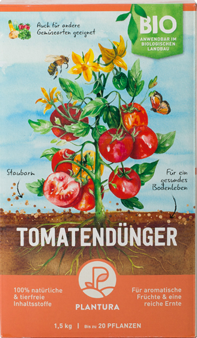
Plantura organic tomato fertilizer
effective long-term effect,
good for the soil, harmless for humans, animals and nature
...and receive concentrated plant knowledge and inspiration directly in your e-mail inbox every Sunday!



